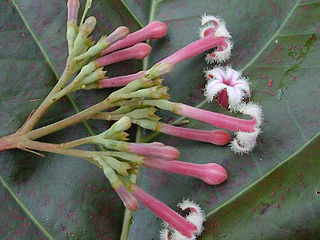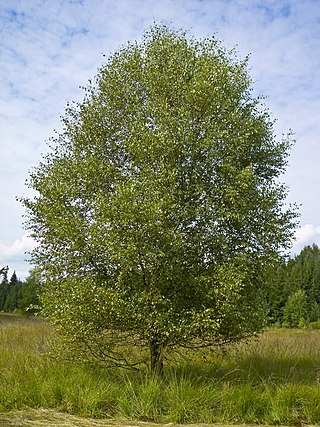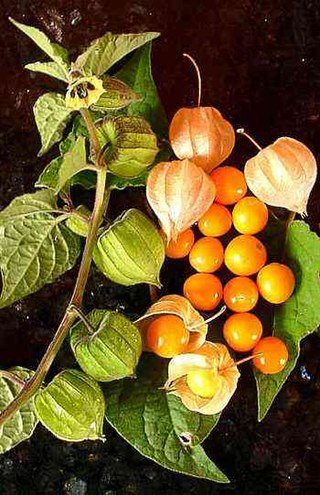
Cinchona is a genus of flowering plants in the family Rubiaceae containing at least 23 species of trees and shrubs. All are native to the tropical Andean forests of western South America. A few species are reportedly naturalized in Central America, Jamaica, French Polynesia, Sulawesi, Saint Helena in the South Atlantic, and São Tomé and Príncipe off the coast of tropical Africa, and others have been cultivated in India and Java, where they have formed hybrids.

Betula pendula, commonly known as silver birch, warty birch, European white birch, or East Asian white birch, is a species of tree in the family Betulaceae, native to Europe and parts of Asia, though in southern Europe, it is only found at higher altitudes. Its range extends into Siberia, China, and southwest Asia in the mountains of northern Turkey, the Caucasus, and northern Iran. It has been introduced into North America, where it is known as the European white birch or weeping birch and is considered invasive in some states in the United States and parts of Canada. The tree can also be found in more temperate regions of Australia.

Betula pubescens, commonly known as downy birch and also as moor birch, white birch, European white birch or hairy birch, is a species of deciduous tree, native and abundant throughout northern Europe and northern Asia, growing farther north than any other broadleaf tree. It is closely related to, and often confused with, the silver birch, but grows in wetter places with heavier soils and poorer drainage; smaller trees can also be confused with the dwarf birch.

Capsicum pubescens is a plant of the genus Capsicum (pepper). The species name, pubescens, refers to the hairy leaves of this pepper. The hairiness of the leaves, along with the black seeds, make Capsicum pubescens distinguishable from other Capsicum species. Capsicum pubescens has pungent yellow, orange, red, green or brown fruits.

Physalis peruviana is a species of plant in the nightshade family (Solanaceae) native to Chile and Peru. Within that region, it is called aguaymanto, uvilla or uchuva, in addition to numerous indigenous and regional names. In English, its common names include Cape gooseberry, goldenberry and Peruvian groundcherry.

The yacón is a species of daisy traditionally grown in the northern and central Andes from Colombia to northern Argentina for its crisp, sweet-tasting, tuberous roots. Their texture and flavour are very similar to jícama, mainly differing in that yacón has some slightly sweet, resinous, and floral undertones to its flavour, probably due to the presence of inulin, which produces the sweet taste of the roots of elecampane, as well. Another name for yacón is Peruvian ground apple, possibly from the French name of potato, pomme de terre. The tuber is composed mostly of water and various polysaccharides.

The mountain papaya also known as mountain pawpaw, papayuelo, chamburo, or simply "papaya" is a species of the genus Vasconcellea, native to the Andes of northwestern South America from Colombia south to central Chile, typically growing at altitudes of 1,500–3,000 metres (4,900–9,800 ft).

Diospyros melanoxylon, the Coromandel ebony or East Indian ebony, is a species of flowering tree in the family Ebenaceae native to India and Sri Lanka; it has a hard, dry bark. Its common name derives from Coromandel, the coast of southeastern India. Locally it is known as temburini or by its Hindi name tendu. In Odisha, Jharkhand, and Assam, it is known as kendu. In Andhra Pradesh, and Telangana it is known as tuniki. The leaves can be wrapped around tobacco to create the Indian beedi, which has outsold conventional cigarettes in India. The olive-green fruit of the tree is edible.

Maclura is a genus of flowering plants in the mulberry family, Moraceae. It includes the inedible Osage orange, which is used as mosquito repellent and grown throughout the United States as a hedging plant. It is dioecious, with male and female flowers borne on separate plants.

Veronica is the largest genus in the flowering plant family Plantaginaceae, with about 500 species. It was formerly classified in the family Scrophulariaceae. Common names include speedwell, bird's eye, and gypsyweed.

Cinchona pubescens, also known as red cinchona and quina (Kina), is native to Central and South America. It is known as a medicinal plant for its bark's high quinine content- and has similar uses to C. officinalis in the production of quinine, most famously used for treatment of malaria.

Otholobium is a genus of flowering plants in the pea family with over 50 named species, but several also remain undescribed so far. Species may be herbaceous perennials, subshrubs, shrubs or small trees. The alternately set leaves are accompanied by stipules and mostly consist of three leaflets, sometimes just one. The inflorescences are on short or long stalks in the axils of the leaves. Within the inflorescences, the pea-like flowers occur in groups of three, rarely of two, subtended by a bract, and each individual flower also is subtended by a narrow bract. The petals may be white, pink, purple or blue, often with a differently colored nectar guide, that may sometimes even be yellow. The seedpods contain just one, black, dark or light brown seed. Most species are restricted to the Cape provinces of South Africa, but some occur at higher elevations in eastern Africa. Charles Stirton erected the genus in 1981. The species in South America will probably be segregated, because these are not sufficiently related to the African species.

Cassytha pubescens is a native Australian hemiparasitic vine species, in the Laurel family. Common names for the species include devils twine, dodder-laurel, spilled devil's twine, snotty gobble or downy dodder-laurel. It is a widespread and common species in south eastern Australia. The species was first formally described in 1810 by the Scottish botanist Robert Brown in Prodromus Flora Novae Hollandiae et Insulae Van Diemen. Leaves are reduced to scales and photosynthesis is achieved through chlorophyll contained in the plants stems. Stems are between 0.5mm and 1.5mm in diameter and the haustoria are between 2 and 3 mm long.

Bakuchiol is a meroterpenoid in the class terpenophenol.
O. pubescens may refer to:

Avenula is a genus of Eurasian flowering plants in the grass family. Over 100 names have been proposed for species, subspecies, varieties, and other infraspecific taxa within Avenula, but only one species is accepted. The others names are all regarded as synonyms of other accepted names. The only recognized species in the genus is Avenula pubescens, commonly known as downy oat-grass or downy alpine oatgrass, native to Europe and Asia from Iceland and Portugal to Xinjiang, Mongolia, and Siberia. It is also naturalized in scattered locations in North America, in states as Connecticut, Delaware, Minnesota, New Jersey and Vermont, and in Canadian provinces such as Alberta, Manitoba, Ontario, Quebec, and Saskatchewan.

Capsicum cardenasii is a plant species in the genus Capsicum and the family Solanaceae. It is a diploid with 2n=2x=24. It is a member within the C. pubescens complex, a group of closely related Capsicum species. It is closely related to C. eximium. It is native to the Andes, and it can be found in Bolivia and Peru. The native name is ulupica.

Psoralea glandulosa is a herb species in the genus Psoralea found in Perú and Chile in South America and also in the United States.

Drupanol is a naturally occurring phenol that has been isolated from the seeds of Psoralea drupaceae. Although drupanol is sometimes said to be the same compound as bakuchiol, the two compounds are in fact distinct; they have the same molecular formula and weight but different chemical structures and hence are structural isomers. Bakuchiol has been found to possess antiandrogenic activity in vitro.
Otholobium accrescens is an upright, largely herbaceous subshrub assigned to the Pea family. It has up to three stems that carry upright branches in leaf axils near the ground, and have alternately set inverted egg-shaped leaves and lax heads consisting of 12-21 pea-like flowers on long peduncles in the axils of the lower leaves. It differs from most other Otholobium species by the calyx that continues to grow after flowering and the leaf that consists of just one leaflet. It is an endemic of the Eastern Cape province of South Africa near Loerie. It probably flowers August to January.

















